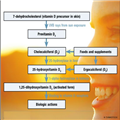April 22, 2011 /
SOURCE: Medscape TodayChristine Gonzalez, PharmD, CHHC – Authors and DisclosuresPosted: 11/11/2010; US Pharmacist © 2010 Jobson Publishing
Introduction
An estimated 1 billion people worldwide, across all ethnicities and age groups, have a vitamin D deficiency.[1–3] This is mostly attributable to people getting less sun exposure because of climate, lifestyle, and concerns about skin cancer. The 1997 Dietary Reference Intake (DRI) values for vitamin D, initially established to prevent rickets and osteomalacia, are considered too low by many experts.[4] DRI values are 200 IU for infants, children, adults up to age 50 years, and pregnant and lactating women; 400 IU for adults aged 50 to 70 years; and 600 IU for adults older than 70 years. Current studies suggest that we may need more vitamin D than presently recommended to prevent chronic disease. Emerging research supports the possible role of vitamin D in protecting against cancer, heart disease, fractures and falls, autoimmune diseases, influenza, type 2 diabetes, and depression. Many health care providers have increased their recommendations for vitamin D supplementation to at least 1,000 IU.[5] As a result, more patients are asking their pharmacists about supplementing with vitamin D.
Pharmacology
Vitamin D is a fat-soluble vitamin that acts as a steroid hormone. The body makes vitamin D from cholesterol through a process triggered by the action of the sun’s ultraviolet B rays on the skin (FIGURE 1). Factors such as skin color, age, amount and time of sun exposure, and geographic location affect how much vitamin D the body makes. Vitamin D influences the bones, intestines, immune and cardiovascular systems, pancreas, muscles, brain, and the control of cell cycles.[6] Its primary functions are to maintain normal blood concentrations of calcium and phosphorus and to support bone health.
 | Figure 1. Vitamin D synthesis. UVB: ultraviolet B. Source: Reference 32. |
Vitamin D undergoes two hydroxylations in the body for activation. There are several metabolic products or modified versions of vitamin D (TABLE 1). Calcitriol (1,25-dihydroxyvitamin D3), the active form of vitamin D, has a half-life of about 15 hours, while calcidiol (25-hydroxyvitamin D3) has a half-life of about 15 days.[6] Vitamin D binds to receptors located throughout the body.
Deficiency, Blood Concentrations, and Toxicity
Risk factors for vitamin D deficiency include living in northern latitudes (in the U.S., above the line from San Francisco to Philadelphia), failing to get at least 15 minutes of direct sun exposure daily, being African American or dark-skinned, being elderly, or being overweight or obese.[5] Rickets and osteomalacia are the well-known diseases of severe vitamin D deficiency. Musculoskeletal pain and periodontal disease may also indicate a significant vitamin D deficiency.[7] Subtle symptoms of milder deficiency include loss of appetite, diarrhea, insomnia, vision problems, and a burning sensation in the mouth and throat.[7] Drawing a blood calcidiol concentration is the standard test for vitamin D status, since calcidiol has a longer half-life.[8]
A normal range of vitamin D is 30 to 74 ng/mL, but this can vary among laboratories.[8] Most experts agree that a concentration between 35 and 40 ng/mL is reasonable for preventive health. Some suggest that the optimal concentration for protecting against cancer and heart disease is between 50 and 70 ng/mL and up to 100 ng/mL. Side effects or toxicity can occur when blood concentrations reach 88 ng/mL or greater.[9] Symptoms include nausea, vomiting, constipation, headache, sleepiness, and weakness.[6] Too much vitamin D can raise blood calcium concentrations, and acute toxicity causes hypercalcemia and hypercalciuria.[6,9]
Continue reading the next (5) sections of this story by clicking here.
Remaining topics: Disease Prevention, Dosing,
You may need to register with Medscape to read the remaining materials.
****************************************************************
Remain CURRENT with Multiple Sclerosis information
when registered at the MS Views and News website
.
***************************************************************************************
.
“Providing You with ‘MS Views and News’, is what we do“
***************************************************************************************
.
Disclaimer: ‘MS Views and News’ (MSVN), does not endorse any products or services found on this blog. It is up to you to seek advice from your healthcare provider. The intent of this blog is to provide information on various medical conditions, medications, treatments, and procedures for your personal knowledge and to keep you informed of current health-related issues. It is not intended to be complete or exhaustive, nor is it a substitute for the advice of your physician. Should you or your family members have any specific medical problem, seek medical care promptly.
.
****************************************************************
Visit our MS Learning Channel on YouTube: http://www.youtube.com/msviewsandnews
Stay informed with MS news and information - Sign-up here
For MS patients, caregivers or clinicians, Care to chat about MS? Join Our online COMMUNITY CHAT



